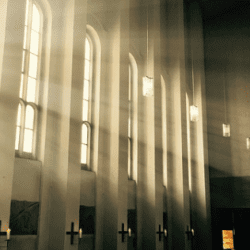We have seen how businesses and organizations such as Wikipedia, Quirky.com, Threadless.com, and even the Department of Energy are using crowdsourcing to generate new ideas or products for their particular application. But in churches, oftentimes that which is culturally or financially appropriate lies at odds with core beliefs of the organization. And so, if we are to consider crowdsourcing as a way to help uncover innovative solutions for the Church, it is right to address questions concerning the theological validity of this methodology. It is to these issue we now turn.
In a court of law, testimony typically exists in an order of importance. First in this hierarchy comes the person directly involved with the issue. However, in their absence or perhaps in addition, witnesses are capable of providing authoritative testimony. Scripture supports this idea as well.[1] To that end, the Apostles, a group of common men without theological pedigree, were authoritative witnesses to the testimony of Jesus’ life and teaching for the early Church.
As this Church began to grow, Saul was a vigorous opponent of Jesus’ followers. Acting on authority of the high priest, Saul set out on a trip to Damascus to round up anyone aligning himself or herself with this new sect and return them to Jerusalem to face the consequences of their actions. However, after a blinding conversion experience on the road to Damascus, Saul abandoned his adversarial intentions and instead began to proclaim throughout the countryside that Jesus was the Son of God… the Christ. In other words, Saul (aka Paul) became an authoritative witness due to his experience with Jesus.
Over time, the Apostles and other witnesses began to die off and in their absence, the written testimony of these witnesses offered a compelling substitute. After a struggle over which documents were in fact authoritative, a collection of these writings were eventually canonized providing the Church with an agreed upon written testimony to the authority of Jesus Christ.
Access to this canon, however remained quite limited due to the time consuming manner associated with generating hand written copies one-at-a-time. As such, they were only to be found in cathedrals, churches, or monasteries.[2] This cloistering away of the Word fueled the dependency of the populace on the Church for biblical information and interpretation. However, this protective custody would begin to evaporate as the1200s brought with it Bibles small enough to be carried in the pockets of monks, allowing the canon to venture outside the walls of the monastery.[3] Later, in the 1300s, scribes began to focus their attention on the domestic market producing elaborately decorated books containing the Psalms for those of financial means.[4] With this gradual migration of the Bible away from the exclusive possession of the church and into the hands of the general populace, the monks and scribes were unknowingly contributing to a journey that would one day land on the steps of a church at Wittenberg.
The 1400s brought with them the arrival of Gutenberg’s printing press. The Church first welcomed this invention as Gods gift to the Church when it helped them raise money for crusades. However, their enthusiasm waned when this new technology enabled the voices challenging ecclesial authority to spread their message of opposition with equal ease and greater enthusiasm.
Martin Luther, the Reformation’s most famous voice, rose to challenge the authority of Church hierarchy in 1517 as he nailed his now famous Ninety-Five Thesis to the door of the church in Wittenberg. The Pope was initially dismissive of Luther’s indictment of the Church, but his attitude changed dramatically when all of Europe was reading and discussing Luther’s challenge on documents enabled by Gutenberg’s printing press. Luther stood before those who presumed to have authority over him and held strong to his convictions with the backing of an ever growing population familiar with his writings. Interestingly, we are currently experiencing a similar explosion of Bible availability as anyone with a smartphone has access to a multiplicity of Bible translations and information in the palm of their hands.
One of the primary tenants of Luther’s theology (the priesthood of all believers) undermined the authority of the Catholic Church as it suggested “every true Christian a priest unto God without need of a special mediator other than Jesus Christ.”[5] Predictably, the Church was somewhat unwilling to share authority with Luther’s priesthood of all believers. However, Luther’s example inspired many a protesting Reformer as the locus of authority began to shift from a central church empowered by the canon to the non-elite leaders of the church.
Historically, churches have approached the problem of authority concerning doctrinal issues from a hierarchical perspective as those in positions of power and leadership determined and sometimes enforced proper theology upon the larger body of disciples. However, when viewed through the lens of apostolic authority in the early church, Paul’s Body of Christ metaphor, and Luther’s priesthood of all believers, one can view this hierarchical model as perhaps contrary to ecclesial intention.
If as Christians, we acknowledge Jesus as the head of the Body of Christ and that Jesus communicates to this body not only through scripture, but also via the Holy Spirit, this brings us to a question: in appropriate scenarios, could a crowd of witnesses act as a sort of spiritual hearing aid, amplifying the still soft voice of the Holy Spirit speaking to the Body of Christ today?
The best way to answer that question is to conduct experiments to help determine the validity and value of crowdsourcing as a proper and reliable tool for the Church. The next and final article in this series discusses the ways in which crowdsourcing is currently being used at crowdsourcingtheology.com to help find solutions to some of the many challenges currently facing the Church.
[1] Deuteronomy 19:15.
[2] Prof. Lori Anne Ferrell, The Bible and the People (New York: Yale University Press, 2008), 27.
[3] Ibid., 28.
[4] Ibid.
[5] Roger E. Olson, The Story of Christian Theology: Twenty Centuries of Tradition and Reform (New York: IVP Academic, 1999), 371.
After many years in the creative and business sides of television and music production on both the local and national level, Dr. Thomas Ingram now divides his time between research/writing and mentoring/coaching/encouraging others in their efforts to pursue God’s purpose for their lives. Ingram is the author of The New Normal: A Diagnosis the Church Can Live With. He holds a Bachelors of Science in Psychology, a Master of Business Administration in Leadership and a Doctor of Ministry in Semiotics and Future Studies. You can connect with Tom’s work at www.thomaseingram.com or email him at [email protected].













